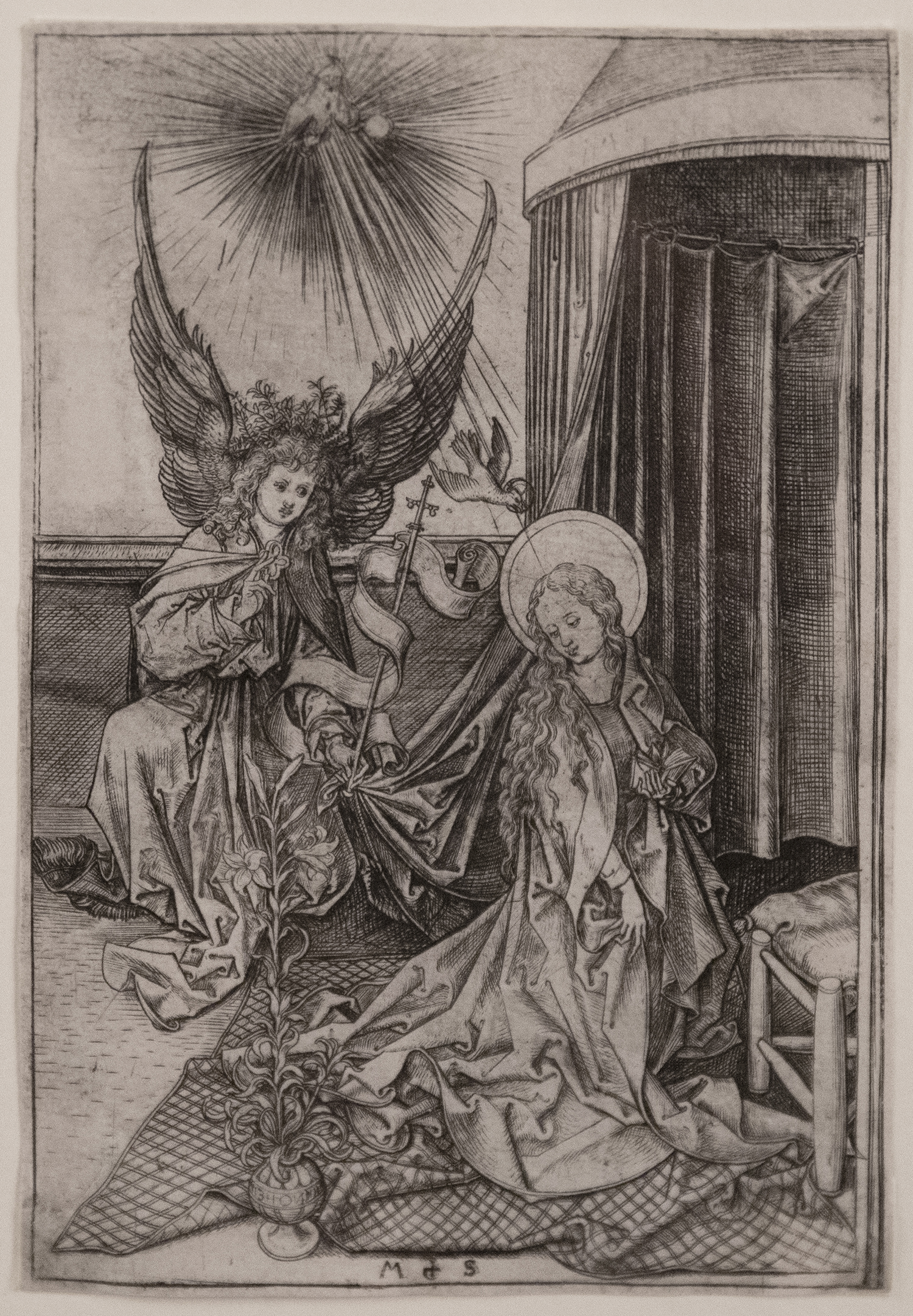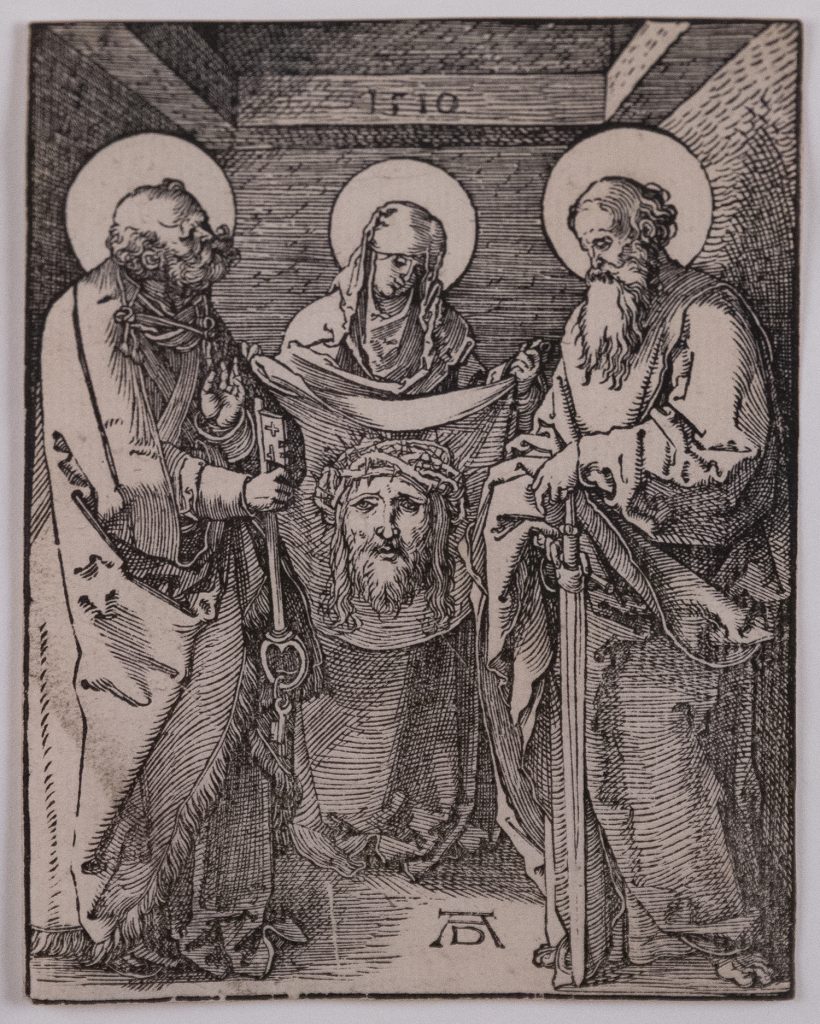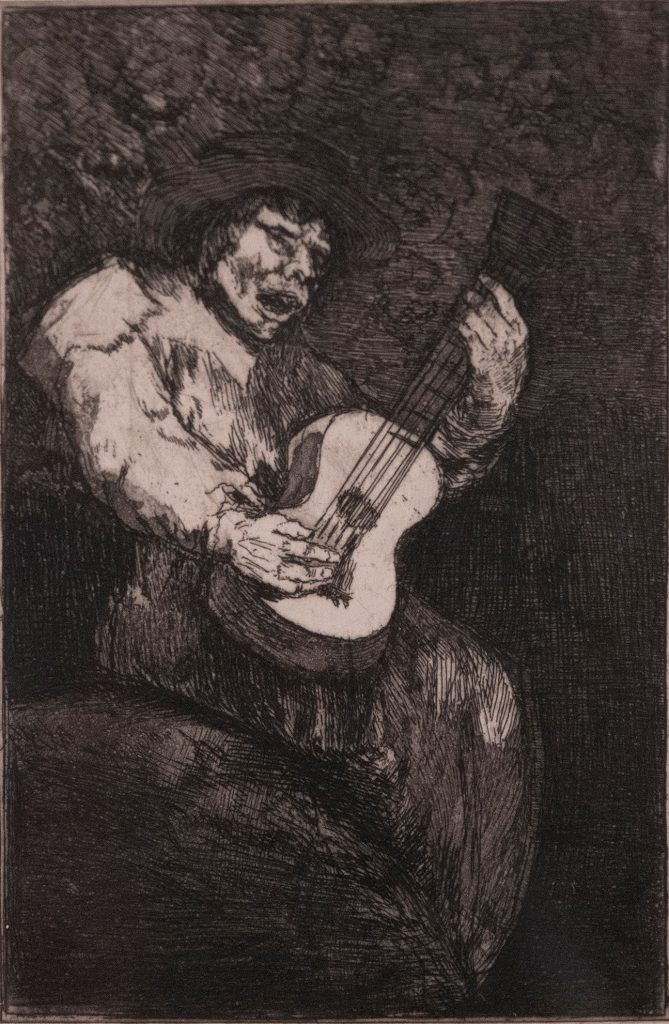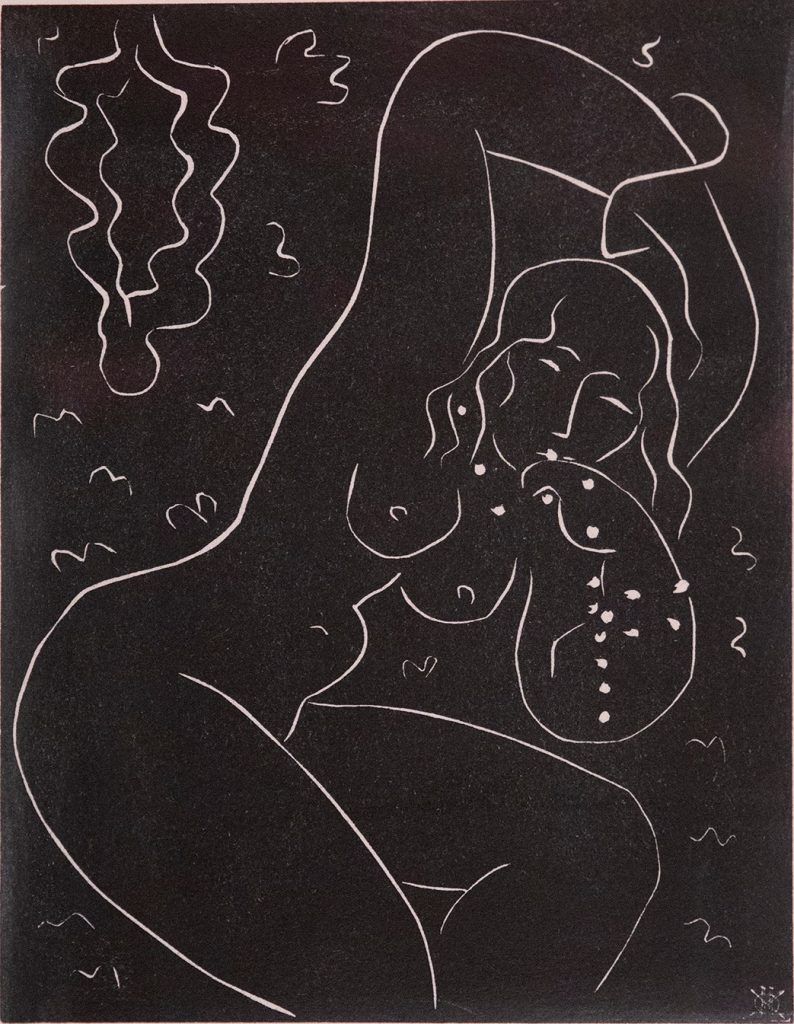I. A History of Art
I. A History of Art
With Professor Theodore Sizer’s syllabus in hand and his inspiring lectures in mind, Jack May set out to collect a representative history of European and American printmaking as the canon was understood in the 1950s. Over the years, he gradually extended the scope of his collection, preferring the grand sweep of art history to intensive coverage of a single period or theme. The result is an astonishingly broad presentation of the different media, techniques, and themes of distinguished artists across the ages. For the first section of the exhibition, we have selected works that introduce some of the major techniques of image printing: woodcut, engraving, etching, aquatint, lithograph, and linocut. Although print artists are still exploring all of these techniques (and more), each method of printmaking first achieved prominence at a different time. As we will see throughout the exhibition, the various techniques of printing informed the development of new visual styles and conventions.

Martin Schongauer (1435-1491)
The Annunciation (1480)
Engraving
6 5/16 × 4 5/8 (16.0 × 11.8 cm)
Collection of Jack May
Martin Schongauer pioneered European engraved art. Like several early engravers (including his admirer Albrecht Dürer), Schongauer came from a family of goldsmiths, masters of an artform that requires the engraving of decorative patterns on metal surfaces. To create an engraving, an artist uses a steel instrument called a burin to incise fine lines on a metal plate, usually copper. After the plate is inked and its surface wiped clean, only the ink remaining in the incised lines will print. Unlike the simpler woodcut, this technique readily accommodates subtle details and complex cross hatching.
The Annunciation narrates the story of the angel Gabriel telling Mary that she will bear the Christ child. Schongauer incorporates standard Christian symbolism to represent a sacred presence, such as lilies for Mary’s virginity and the dove for the Holy Spirit. Moreover, he skillfully produces an illusion of light emanating from God through intricate hatching. The action of the flowing cloth, which connects the figures to their setting, creates a sense of three-dimensional space, even though Schongauer does not use perspective. The schematic folds of the fabric and the weightless S-shaped curves of the bodies exemplify Schongauer’s late Gothic style.
Christopher Elliott
Vocal Music Education
Class of 2022
HART 2775: History of Prints
Recommended Sources
Krohm, Hartmut, and Jan Nicolaisen, ed. Martin Schongauer: Druckgraphik im Berliner Kupferstichkabinett. Berlin: Staatliche Museen Preussischer Kulturbesitz, 1991
Le beau Martin: Gravures et dessins de Martin Schongauer. Colmar: Musée d’Unterlinden, 1991
Shestack, Alan. The Complete Engravings of Martin Schongauer. New York: Dover, 1969

Albrecht Dürer (1471-1528)
Veronica’s Veil, from Small Passion (1511)
Woodcut
5 × 3 7/8 (12.7 × 9.8 cm)
Collection of Jack May
Albrecht Dürer leveraged his tremendous success as a painter to elevate the status of the woodcut to the level of high art. As the name suggests, a woodcut print is the impression of a design that has been cut into a woodblock. The image is what has been left standing in relief on the block after the artist has cut or chiseled off areas to be blank. Due to the difficulty of cutting intricate lines and hatching, skilled artisans called “formcutters” often rendered the artist’s drawings on the wood.
Veronica’s Veil exemplifies the Renaissance compositional refinements Dürer introduced to the woodcut: realistic rendering of the bodies in a weight-shifted stance (called “contrapposto”), virtuoso handling of light and shading, as well as the use of perspective to create a rationalization of three-dimensional space in the two-dimensional medium. Equally impressive, Dürer applies a meticulous balance of cross and linear hatching to convey the volume and weight in the clothing of the saints.
The subject matter also evokes the Italian Renaissance, for the actual Veil of Veronica is a revered relic in Rome’s St. Peter’s Basilica, the greatest architectural project of the era. The relic, called the simulacrum (“image”), is said to have captured Christ’s visage “imprinted” on a cloth that Veronica gave him to wipe his face before the crucifixion. Thus, Dürer’s woodcut is a printed image of a printed image.
Chloe Davis
History of Art and Anthropology
Class of 2020
HART 2775: History of Prints
Peter Stidman
Law, History, & Society
Class of 2023
Immersion Project
Recommended Sources
Panofsky, Erwin. The Life and Art of Albrecht Dürer. Princeton: Princeton University Press, 1955
Price, David H. “Continuities in Anti-Judaism: Reassessing the Nuremberg Banishment from the Perspective of Albrecht Dürer and His Generation.” Schriften des Vereins für Reformationsgeschichte 219 (2019): 157-179
Price, David H. In the Beginning Was the Image: Art and the Reformation Bible. Oxford: Oxford University Press, 2021
Jacques Callot (1592-1635)
The Battle, plate 3 of the Miseries and Misfortunes of War (1633)
Etching
3 3/16 × 7 5/16 (8.1 × 18.6 cm)
Collection of Jack May
Creator of over fourteen hundred works, the French artist Jacques Callot is one of the most significant innovators in the history of etching. To make an etching, the artist scratches lines through an acid-resist “ground,” a thin coating of resin on a metal plate. Then, acid is applied in order to “etch” the plate where the artist has scratched through the ground. The technique, first developed in the early sixteenth-century in Augsburg, became a major medium for print artists in the seventeenth century and thereafter. Callot introduced the use of a more stable “hard ground” made of varnish and, equally important, invented the échoppe, a new etching needle that enabled the artist to vary the thickness of a line, as was possible with an engraving. He also refined the technique of using multiple “bitings” (immersion in acid) of the plate.
The Battle illustrates the complexity of Callot’s compositions, which frequently feature a great number of figures and details. This etching, which is from the beginning of a series of eighteen plates portraying the miseries of war, conveys a sense of the unremitting horrors of battle, stretching from the distinct corpses of the foreground to the seemingly unending horde of soldiers fading into the horizon. The background fading depends on subjecting the foreground parts of the plate to more acid bitings.
Harrison Denman
Class of 2023
HART 2775: History of Prints
Recommended Sources
Hornstein, Katie. “Just Violence: Jacques Callot’s Grandes Misères et Malheurs de la Guerre.” Bulletin of the University of Michigan Museums of Art and Archeology 16 (2005): 29-48
Lieure, Jules. Jacques Callot. 8 vols. Rpt. New York: Collectors Editions, 1969

Francisco Goya (1746-1828)
The Blind Singer (1815)
Engraving and aquatint
7 1/2 × 4 13/16 (19.1 × 12.2 cm)
Collection of Jack May
In addition to his fame as a painter, Francisco Goya remains an influential printmaker whose large oeuvre of three hundred prints spans stylistic movements from the Rococo to Neo-classicism and Romanticism. Goya was one of the most significant artists of the aquatint, a popular print technique in the late eighteenth century. His dramatic use of aquatint’s tonal and atmospheric qualities revitalized the medium in the nineteenth century and continues to inspire artists today. Goya often uses this technique in conjunction with engraving, capturing both the sharp lines of the engraving and the painterly tonality of the aquatint.
Aquatint is a variant of etching that produces areas of tone rather than lines. This is achieved by coating the printing plate in acid-resistant resin of fine granules so that when the plate is immersed in acid, the plate is etched between the granules. The result looks like a watercolor. Combining the aquatint process with etching, Goya achieves a striking chiaroscuro contrast (between light and dark). In The Blind Singer, Goya juxtaposes line and shadow to portray the dramatic emotionality of the singer immersed in the depths of his song, perhaps a modern evocation of Homer.
Sarah Treadway
Medicine, Health, and Society and Child Development
Class of 2021
Immersion Project
Recommended Sources
Forty, Sandra. Francisco De Goya. Charlotte: TAJ Books International, 2014
Gassier, Pierre, and Juliet Wilson Bareau. The Life and Complete Works of Francisco Goya. New York: Reynal, 1971
Tomlinson, Janis. Goya: A Portrait of the Artist. Princeton: Princeton University Press, 2020
Martin Lewis (1881-1962)
Rain on Murray Hill (1928)
Drypoint
7 7/8 × 11 7/8 (20 × 30 cm)
Collection of Jack May
Since its origin in the fifteenth century, drypoint has involved sketching on a metal plate with a needle (or stylus) to create burred incisions that will hold the ink for printing. Although similar to engraving, drypoint lines are made by scraping with a needle, rather than cutting with a v-shaped burin that removes the excess metal. Additionally, due to the slight fuzziness created by the burrs, drypoint is often used in conjunction with other techniques on the same plate, such as etching or engraving, creating rough markings to juxtapose sharp lines.
In his virtuoso drypoint Rain on Murray Hill, Lewis depicts a street corner near the Empire State Building inundated by rain. On the one hand, Lewis capitalizes on drypoint’s coarse, hazy nature, capturing distorted reflections and streaking rain. Simultaneously, he bends the medium to his will, sculpting intricate townhouses and sharply outlined people near the viewer. By both accentuating and taming the drypoint’s jaggedness, Lewis became a modern master of this five-hundred-year-old technique.
Peter Stidman
Law, History, & Society
Class of 2023
Immersion Project
Recommended Sources
Gatti, Chiara. Martin Lewis. Milan: Digiteam, 2002
Griffiths, Anthony. Prints and Printmaking: An Introduction to the History and Techniques. 2nd ed. Berkley: University of California Press, 1996
McCarron, Paul. The Prints of Martin Lewis: A Catalogue Raisonné. Bronxville, NY: M. Hausberg, 1995
Strike, Karen. “New York City by Martin Lewis – Edward Hopper’s Mentor Captures America’s Success and Failure.” Flashbak, https://flashbak.com/, 2019
Ron Adams (b. 1934)
Blackburn (2002)
Lithograph
29 1/2 × 39 (74.9 × 99.1 cm)
Dr. and Mrs. E. William Ewers Gift for Fine Arts Fund Purchase
Collection of Vanderbilt University Fine Arts Gallery
Noted for his color lithographs of African-American culture, Ron Adams often endows figures with the appearance of mythical strength even in mundane situations. His portrait of Robert Blackburn shows his friend and fellow artist powerfully pulling a print from a lithographic stone at the Printmaking Workshop in New York City. Founded by Backburn in 1947 and now called Robert Blackburn Printmaking Workshop, this studio became a center for international graphic arts innovation and collaboration, particularly for artists of color. Although Blackburn’s health was failing, Adams portrays the artist’s persistent dedication to his vocation as a teacher, master printmaker, and community advocate.
The curators have selected this work, the only print in the exhibition not associated with the May Collection, as a gesture to indicate the compatibility of the May Collection with Vanderbilt’s extensive print holdings. Moreover, this lithograph celebrates the artistry of the medium. Made by drawing directly with an oil crayon on a polished limestone block (visible here on the bed of the press), lithographic production can feel like a mixture of chemistry and magic. Since each color requires a separate stone, the printing process is complex and often handled by a master lithographer rather than the artist. This vibrant lithograph has seven separate colors.
Cainie Brown
Anthropology and History of Art
Class of 2022
Immersion Project & HART 2775: History of Prints
Recommended Sources
Cullen, Deborah. “Blackburn, Robert.” Grove Dictionary of Art. Oxford Art Online
Cullen, Deborah. “Robert Blackburn: Revisioning Graphics.” Nka: Journal of African American Art 11 (2000): 64-69
Green, Harriett, Nina Parrish, Grace Hartigan, Michael Kelly Williams, and Elizabeth Catlett. Robert Blackburn: A Life’s Work. New York: The Alternative Museum, 1988
Mella, Joseph, and James Rutherford. Ron Adams, Master Printmaker: A Survey of Works, 1984-1999. Nashville: Vanderbilt University Fine Arts Gallery, 2000

Henri Matisse (1869-1954)
Nu au bracelet (1940)
Linocut
12 5/8 x 9 3/4 (32 x 24.8 cm)
Collection of Jack May
In Nu au bracelet (“nude with bracelet”), a female figure lounges, floating in an undefined space, wearing only a bracelet. Rendered in black and white, the print is a linocut, a modern equivalent of the woodcut. The only difference is that the artist uses a scalpel to cut the design into linoleum (which is easier to cut) rather than knives and chisels to carve a block of wood.
Known primarily for his paintings, Matisse was one of the founding artists of Modernism, a revolution in the arts that traded realism for abstraction. Form, line, and color become the subject matter rather than the figures they represented. Admired for his sparing detail, Matisse favors the arabesque, sinuously curved line, as is evident in the contours of the human body. The color palette, much like the forms, is minimalist and shifts the viewer’s focus to the linear harmony of the composition. With its elegant lines and reduced forms, Nu au bracelet exemplifies Modernism’s simplified compositions and Matisse’s ability to express unencumbered joy in beauty.
Chloe Davis
History of Art and Anthropology
Class of 2020
HART 2775: History of Prints
Recommended Sources
Duthuit-Matisse, Marguerite, and Claude Duthuit. Matisse: catalogue raisonné de l’œuvre gravé. Paris: C. Duthuit, 1983



